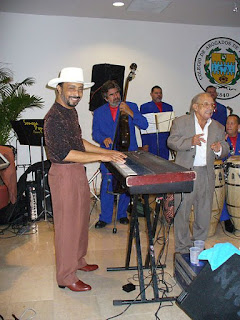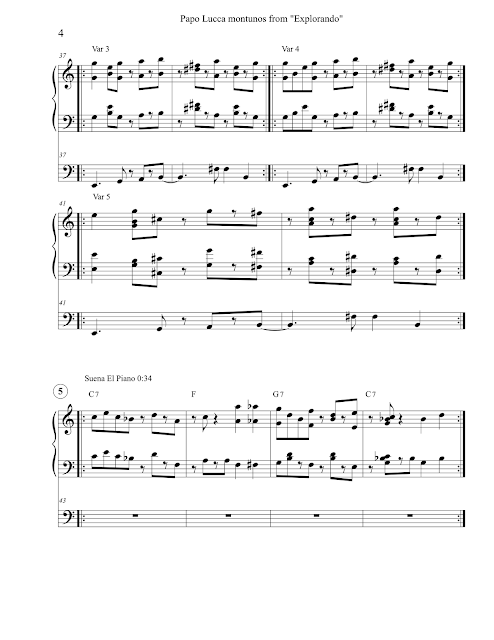Papo Lucca: Montunos
We interrupt your regularly scheduled programming for a guest post! Enjoy pianist Malcolm Campbell on Papo Lucca's approach to montuno playing.
 |
| Papo Lucca, smiling |
More so than in jazz, the pianist in salsa music is central
to the rhythmic drive of the band.
Since the percussion is spread out over a whole section of people, the
pianist is much more akin to a jazz drummer in terms of the personal
responsibility he has for the groove.
On top of this, he is also the primary (sometimes the only) chordal
instrument.
Papo basically has three modes of playing on this album:
arranged hits, montuno, and ad lib comping/soloing. The intros are usually arranged hits, and verses are mostly
montunos connected by bars of arranged hits. The montunos I’ve transcribed here come from choruses, where
they stay on one groove/set of changes for a while. Towards the end of songs,
choruses sometimes evolve into several minute jams where the singers drop out,
letting the band go crazy on the montuno, coming back in to cue the
ending. These sections always
involve some permutation of I IV V (montunos 1, 4, and 5), or a cycle of fifths
(montunos 2 and 3), in major (montunos 1, 2, 5) or minor (montunos 3, 4). A cool harmonic trick is to start on I7
in a minor progression, kicking of a cycle of fifths that ends on i in minor
(montuno 3).
Most of the montunos transcribed here happen somewhere
towards the middle of the song.
This is something I’ve noticed about the montunos on this album: they
come and go, sometimes only lasting for 16 bars or so. This is part of the brilliance of Papo
Lucca’s arranging. Hearing a
montuno start and the band settle into a groove is one of the great moments in
a salsa song, so Papo arranges tunes so that you get several of these
moments. By alternating between
montuno sections and rhythmic hits and/or solos, he gives you several montuno
break downs in every song.
Pianistically, the most common pattern is to have octaves in
the right hand (1st and 5th finger) alternating with two
notes in the middle (2nd and 3rd finger), such as in
montunos 2, 3, and 4. The left
hand plays the same thing an octave lower, leaving out the upper octave. If you want a more relaxed sound, you
can leave out the top octave (e.g. montuno 1).
To maintain interest, it’s really key to vary the
rhythm. You can do this by
arpeggiating the middle two notes, or by slightly changing the pattern of on
vs. off-beat. Usually, the montuno
hits the downbeat every two bars, with all offbeats in between. It sounds great if change the pattern
every once in a while, for example in montuno 4 variant 2, where instead of
playing the downbeat on 1 he plays it on beat 3 of the second bar. If you can work in contrary motion (montuno
5), you are taking it to the next level.
This album is a great place to start studying salsa
piano. Other great montunos that
aren’t transcribed here are: Jubileo 20 starting at 3:03, Se Formó at 3:07, and
Sentimento Jibaro at 2:05 (somewhat unusual changes). The solo on Moreno Soy (starting at 3:14) isn’t a montuno,
but it’s a great example of how to solo over this kind of groove. Enjoy!
Here are links to the recordings from which these montunos were transcribed:
Here are links to the recordings from which these montunos were transcribed:
Malcolm Campbell (Harvard '14, New England Conservatory '15) is a jazz pianist and composer based in Cambridge, MA.




Thanks so much for these transcriptions, I enjoy Papo Lucca's music very much and considered him to be one of the most creative pianists in latin music.
ReplyDeletesi muy util el material aportado ideal para nutrirse de esta fabulosa musica gracias desde argentina
ReplyDelete